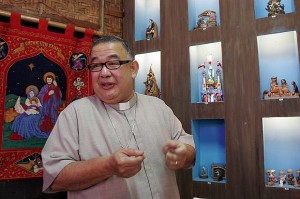
In this 2008 file photo, Msgr. Cris Garcia shows his collection of nativity scenes or “belen” displayed during Christmas in the monastery of the Angel of Peace in Cansojongm Talisay City. (CDN FILE PHOTO)
A National Bureau of Investigation (NBI) official has cleared a prominent Cebu priest of involvement in the illegal trade and possession of ivory.
NBI supervising agent Gregorio Algoso yesterday said the NBI Region 7 office found no sufficient evidence to pin down Msgr. Cristobal Garcia who was linked by an October 2012 National Geographic magazine report to the illegal ivory trade.
“We really could not establish that Msgr. Garcia is engaged in (ivory) smuggling. Besides, by just reading the article and without giving any supporting document would tell us that the accusations remain a hearsay,” Algoso told Cebu Daily News yesterday.
Of about 5,000 religious icons owned by Garcia, which the NBI inspected, Algoso said only three appeared to be made of ivory.
Mostly the hands and feet of the icon were ivory, while the body was made of wood.
The NBI could not hold Garcia liable for illegal possession because the ivory may have been acquired before the global ban on ivory trade took effect in 1989.
The findings were made in a report by the NBI 7 office in October 2013 after the ivory scandal broke two years ago triggering a national investigation by the NBI and the DENR’s Protected Area Wildlife Bureau in Manila.
Algoso said the three ivory images have not been subjected to confirmatory examination because the Department of Environment and Natural Resources (DENR) has not provided an expert to determine the age of the ivory.
“Based on that, there’s nowhere further for us to go. We were waiting for an update from DENR because they promised to look for experts from the National Museum, but we don’t have any feedback from them,” he said.
“So our conclusion is that there’s really insufficient evidence (against Msgr. Garcia). The case is temporarily closed unless there will be other evidence enough to reopen the case,” he added.
Msgr. Garcia’s personal collection of Sto. Niño icons and other religious images started when he was a boy.
Algoso said when he questioned the monsignor about the allegations of involvement in ivory smuggling, the priest denied any participation.
In his interview with the National Geographic magazine, Msgr. Garcia showed the writer his collection of icons and was quoted as telling the reporter Bryan Christy how to smuggle ivory into the United States: “Wrap it in old, stinky underwear and pour ketchup on it.”
The priest was also quoted as suggesting that Christy could get a certificate from the National Museum of the Philippines declaring an image as “antique” or declare it as an imitation and alter the carving date before the ban.
After the cover story came, several friends of Msgr. Garcia in heritage and culture circles in Cebu cried foul, saying Christy had befriended them and the priest on the pretext that he wanted to write about the Filipino religious devotion to the Sto. Niño.
They didn’t realize that Christy, a lawyer and investigative reporter, was researching for an expose about the illegal ivory trade in various countries, mainly China and Africa.
The article opened with a lengthy description of the monsignor and his extensive collection of icons, highlighting his in-depth knowledge of where to find and buy ivory figures in Manila. The priest shared his contacts with the writer.
Garcia’s close friends said the advice about smuggling ivory in the article was “misconstrued and exaggerated.”
“I suggest that if we want to go deeper in this issue, there should be a sworn statement of the writer which is unlikely because he’s not from the Philippines,” said NBI’s Algoso.
“If he’s (Christy) willing to come back here, we’ll take his statement and we’ll know how he got the information,” he added.
“Based on our investigation, he has only three icons made of ivory. Usually, only the hands and face of the images are made of ivory since the other parts of the icons are actually made of wood. We’re also very careful on that aspect because (they may be acquired) before 1981 when ivory is not illegal in the Philippines yet,” the investigator said.
Algoso was referring to the Convention on International Trade in Endangered Species of Wild Fauna and Flora (CITES) which declared a global ivory trade ban.
Louie Nacorda, an iconographer in Cebu who writes about religious traditions and heritage in Cebu, said he was relieved to hear the priest was cleared.
“I’m happy for Msgr. Cris. There is really no reason he should be accused of ivory smuggling or illegal possession. What if he just inherited his ivory pieces from his grandparents?” Nacorda said in a text message to CDN.
Fr. Glenn Therese Guanzon, who replaced Msgr. Garcia as head of the archdiocese’s Commission on Worship, also expressed relief.
“The truth has surely set us all free. From the start, we always believed that Msgr. Cris is innocent. It’s a gift from the Sto. Niño to Msgr. Cris and to the church of Cebu,” Guanzon told CDN.